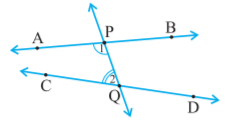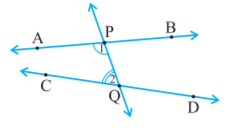NCERT Solutions for Exercise 5.2 Class 9 Maths Chapter 5 - Introduction To Euclid's Geometry
The topic of Euclid's postulate, specifically its fifth postulate, is covered in NCERT Solutions for Class 9 Maths exercise 5.2. Euclid's Geometry is the study of geometry based on undefined words such as points, lines, and planes of flat spaces, which was developed by Euclid, the Father of Geometry. In exercise 5.2 Class 9 Maths, Euclid's Euclid's geometry discussed the shape, size, and position of solid shapes such as the surface, straight or curved lines, points, and so on… Geometrically, there are 5 Euclid’s postulates They are,
This Story also Contains
- Introduction To Euclid's Geometry Class 9 Chapter 5 Exercise: 5.2
- More About NCERT Solutions for Class 9 Maths Exercise 5.2
- Benefits of NCERT Solutions for Class 9 Maths Exercise 5.2
• Postulate -1: A line segment is often drawn for any two given points.
• Postulate -2: A-line segments are often extended in either direction to make a line
• Postulate -3: To explain a circle with any centre and radius, that's a circle that is often drawn with any centre and any radius.
• Postulate -4: All right angles are proportional to one another.
• Postulate -5: If two lines are intersected by a third in such a way that the total of the inner angles on one side is less than two right angles, then the two lines will intersect endlessly on that side.
NCERT solutions for Class 9 Maths chapter 5 exercise 5.2 are made up of two questions that are based on Euclid's fifth postulate. In this Class 9 Maths chapter 5 exercise 5.2, the ideas connected to Euclid's Geometry are thoroughly discussed. Along with NCERT book Class 9 Maths chapter 5 exercise 5.2 the subsequent exercises also are present.
Introduction To Euclid's Geometry Class 9 Chapter 5 Exercise: 5.2
Q1 How would you rewrite Euclid’s fifth postulate so that it would be easier to understand?
Answer:
Euclid's postulate 5: If a straight line falling on two straight lines makes the interior angles on the same side of it taken together less than two right angles, then the two straight lines, if produced indefinitely, meet on that side on which the sum of angles is less than two right angles.
 Now, in an easy way
Now, in an easy way
Let the line PQ in falls on lines AB and CD such that the sum of the interior angles 1 and 2 is less than 180° on the left side of PQ. Therefore, the lines AB and CD will eventually intersect on the left side of PQ.
Q2 Does Euclid’s fifth postulate imply the existence of parallel lines? Explain.
Answer:  According to Euclid's 5 postulates, the line PQ falls on lines AB and CD such that the sum of the interior angles 1 and 2 is less than 180° on the left side of PQ. Therefore, the lines AB and CD will eventually intersect on the left side of the PQ
According to Euclid's 5 postulates, the line PQ falls on lines AB and CD such that the sum of the interior angles 1 and 2 is less than 180° on the left side of PQ. Therefore, the lines AB and CD will eventually intersect on the left side of the PQ
Now,
If $\angle 1+\angle 2 = 180^\circ$ then, the line never intersects with each other.
Therefore, we can say that lines AB and CD are parallel to each other
More About NCERT Solutions for Class 9 Maths Exercise 5.2
Class 9 Maths chapter 5 exercise 5.2, The fifth postulate of Euclid geometry states that if any straight line falling on two straight lines produces interior angles on the same side of it that are less than two right angles when added together, then the two straight lines will meet on the side on which the sum of angles is less than two right angles if produced indefinitely.
Euclid proposed the fifth postulate. John Playfair's most recent version of Euclid's fifth postulate. Provided a line and a point not on it in a plane, he claims that only one line parallel to the given line can be traced through the point. This fifth postulate is commonly referred to as the parallel postulate since it is based on the uniqueness of parallel lines.
Benefits of NCERT Solutions for Class 9 Maths Exercise 5.2
• Through NCERT solutions for Class 9 Maths exercise 5.2, we will easily comprehend Euclid’s fifth postulate and these questions will assist us in mastering the principles of Euclid's geometry.
• If we look at the NCERT solution for Class 9 Maths chapter 5 exercise 5.2, we can easily remember all important terms introduced in Euclid’s geometry.
• For solving the questions of exercise 5.2 Class 9 Maths, we need to memorize the definitions and theorems clearly to understand and reinforce their knowledge. This may help gain a deep understanding of this topic.
Popular Questions
Courses After 12th
Applications for Admissions are open.
As per latest syllabus. Physics formulas, equations, & laws of class 11 & 12th chapters
JEE Main Important Chemistry formulas
Get nowAs per latest syllabus. Chemistry formulas, equations, & laws of class 11 & 12th chapters
JEE Main high scoring chapters and topics
Get nowAs per latest 2024 syllabus. Study 40% syllabus and score upto 100% marks in JEE
JEE Main Important Mathematics Formulas
Get nowAs per latest syllabus. Maths formulas, equations, & theorems of class 11 & 12th chapters
